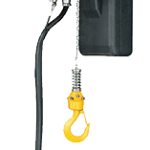Archive for September 2018
“Brand” New Warehouse Signs
David Grundy, ASG Services, LLC Warehouse signs, the functional, simple and often forgotten essential of the storage and distribution industry, have just been brought to the fore with a “brand” new boost by ASG Services. While retaining all the key performance benefits of functional signage, ASG is moving the benchmark once again, by giving customers…
Read MoreHVLS Fans: How Air Quality Impacts Workplace Health & Your Bottom Line
Jeff Chastain, Hunter Industrial Senior Vice President & General Manager Do you have a high-volume, low-speed (HVLS) fan in your facility? If so, you are already a step ahead of the game. However, the question you now need to ask yourself is: Have you chosen the right fan for your facility? For those who have…
Read MoreSafeguard Against Machine Hazards, Injuries with Employee Training
The first day on the job for a new employee ended tragically, when the 21-year-old man suffered severe burns and the loss of four fingers on his right hand as he tried to clear a jam in a plastic molding machine. The man had only been working for a few hours when the incident occurred.…
Read MoreEmployer Responsibilities Under OSHA’s New Crystalline Silica Rules
To better protect workers, OSHA issued two new respirable crystalline silica standards: one for construction and the other for general industry and maritime. OSHA began enforcing most provisions of the standard for construction on September 23, 2017 and began enforcing most provisions of the standard for general industry and maritime on June 23, 2018. In…
Read MoreWarehouse Management Software: Key to Traceability in the Global Marketplace
Traditional warehousing operations are typically managed using either a warehouse management system (WMS), a warehouse control system (WCS) or both. The WMS is used to manage the workflow of the operation, while the WCS is used to execute the workflow by controlling the automation. When tightly integrated, they make up a warehouse execution system (WES).…
Read MoreBest Practices to Reduce Warehouse Downtime
Kyle Krug, Director of Marketing, LEGACY Supply Chain Services As warehouses increasingly rely on technology, the potential for downtime due to a tech failure or system problem is on the rise as well. While downtime may be unavoidable, it doesn’t have to be debilitating. Here are some ways to reduce warehouse downtime; recover more quickly;…
Read MoreCranes, Hoists and Overhead Handling Equipment
Overhead handling equipment, such as cranes and hoists, can increase productivity and make the best use of floor space, as well as enhance safety and improve ergonomics in a facility. Overhead materials handling equipment comes in many forms, but each has the same basic goal: to safely lift product and move it (efficiently and ergonomically)…
Read MoreSolving the Labeling Challenge: How to Find the Right Solution for Your Business
From supply and manufacturing to distribution and shipping, the label is an essential part of any successful supply chain. What might look like a simple series of laminations to the untrained eye actually represents a complex design process and a key component of business success. With a vast variety of material, environmental and industry-specific factors…
Read MoreEyewashes & Showers Protect Workers from Hazardous Substances
Emergency showers and eyewash stations provide on-the-spot decontamination. They allow workers to flush away hazardous substances that can cause injury. Even with the best engineering and safety precautions, accidental chemical exposures still occur. As a result, it is essential to look beyond the use of goggles, face shields and procedures. Emergency showers and eyewash stations…
Read MoreDon’t Get Tripped Up by OSHA’s Walking-Working Surfaces Standard
Rayaz Qureshi-Chishti, J.J. Keller OSHA’s efforts to address slips, trips and fall hazards in General Industry began in 1971, when it created 1910 Subpart D, “Walking-Working Surfaces.” Since that time, efforts to revise these requirements have been ongoing, including proposed rules issued in 1973, 1990 and 2010. The most recent proposal, finalized in 2016, impacted…
Read More







